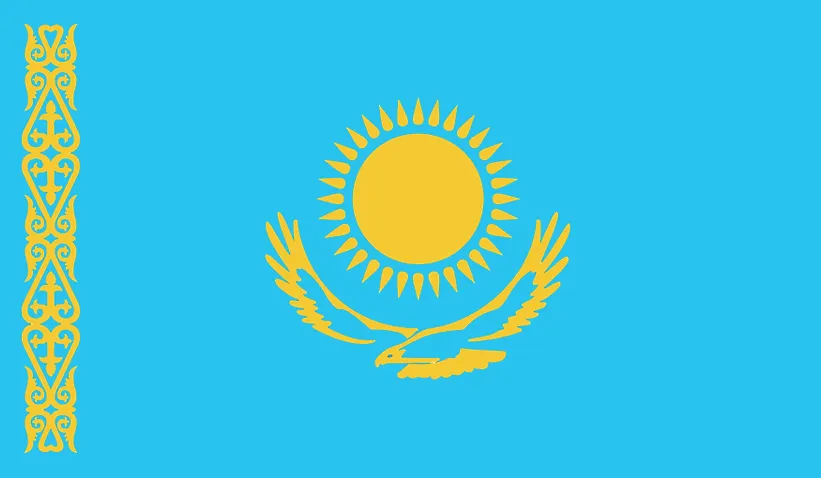
カザフスタン
| 大陸 | アジア |
| 資本金 | アスタナ |
| 人口 | 18,360,353 |
| GDP | $469億円 |
| 一人当たりGDP | $25,700 |
| ダイヤルコード | +7 |
| ISOコード(2文字) | KZ |
| ISOコード(3文字) | カザフスタン |
カザフスタンについて
世界最大の内陸国であり、古代のシルクロードの遺産が現代の野心と出会う国、カザフスタンへようこそ。270万平方キロメートル、人口1,900万人のカザフスタンは、東欧と中央アジアの架け橋であり、伝統と進歩のユニークな融合を体現しています。
地理的特徴と自然の美しさ
カザフスタンの広大な領土は、南東の天山山脈から西のカスピ海沿岸まで、驚くべき地理的多様性を包含している。ドラマチックなチャリン渓谷や手つかずの自然が残るコルサイ湖など、カザフスタンには自然の驚異が数多くある。
国土の約3分の1を占める大草原からアルタイ山脈まで、マンギスタウ地方の奇岩からキジルクムやモインクムの広大な砂漠まで、その景観は実にさまざまだ。この多様性が、独自の生態系を支える複数の気候帯を生み出している。
保護区には、カザフスタン最古の保護区であるアクス・ジャバグリ自然保護区や、ピンクフラミンゴの世界最北の生息地であるコルガルズィン州立自然保護区などがある。
文化遺産と伝統
カザフスタンの文化は、遊牧民の伝統とシルクロード沿いのさまざまな文明の影響を反映している。伝統的な習慣は、もてなしの心、年長者への敬意、自然とのつながりを重視する一方、現代のカザフスタンは多文化の多様性を受け入れている。
この国の芸術的伝統には、独特の織物芸術、特にユルトや装飾品のためのフェルト作りがある。伝統音楽にはドンブラのような独特の楽器があり、口承伝統には古代の叙事詩や民間伝承が残されている。
カザフ料理は遊牧民の伝統を反映しており、ベシュバルマクやカジーといった伝統料理は、文化における肉の重要性を強調している。クミス(発酵させた雌馬の乳)を分け合う伝統は、もてなしの象徴であり続けている。
歴史の旅
カザフスタンの歴史は、古代の遊牧文明からさまざまな帝国を経て、1991年の独立に至る。この地域はシルクロードの交易網で重要な役割を果たし、後にロシア帝国とソビエト連邦の一部となった。
カザフ・ハン国の発展、ロシアの植民地化、ソビエト時代の変革、独立への挑戦と達成など、重要な時代を含む。1997年のアスタナ(現ヌルスルタン)への首都移転は、カザフスタンの近代的野心を象徴するものであった。
現代の経済状況
今日の中央アジア最大のカザフスタン経済は、膨大な天然資源と野心的な開発構想を兼ね備えている。カザフスタンの石油と鉱物資源が経済成長を支える一方で、多角化の努力はテクノロジーとイノベーションに重点を置いている。
最近のイニシアチブは、デジタルトランスフォーメーション、再生可能エネルギー開発、インフラ近代化に重点を置いている。カザフスタンの戦略的立地は、地域経済統合を促進する一方で、中国の「一帯一路」構想におけるカザフスタンの役割を支えている。
国際関係とグローバルポジション
カザフスタンは、多方面にわたる外交政策を維持し、大国との関係のバランスをとりながら、地域協力を推進している。核不拡散と平和的国際関係に対するカザフスタンのコミットメントは、世界的な尊敬を集めている。
ご存知でしたか?
- カザフスタンにはバイコヌール宇宙基地がある。
- 国旗には黄金の太陽と鷲が描かれ、自由と国の高い志を象徴している。
- 古代のリンゴの原産地はカザフスタンの天山山脈?
- ポロ競技に似ているが、ヤギの死骸でプレーする伝統的なゲーム、コッカルは今も人気があるのだろうか?
結論
カザフスタンは、古くからの伝統と現代的な願望が融合したユニークな国です。広大な草原から近代的な都市まで、豊かな文化遺産から経済的な成果まで、カザフスタンは独自のアイデンティティを保ちながら進化し続けています。経済の多様化や環境保護などの課題に取り組む中で、カザフスタンは持続可能な発展を追求しながら、東洋と西洋の架け橋としての役割を果たし続けている。





